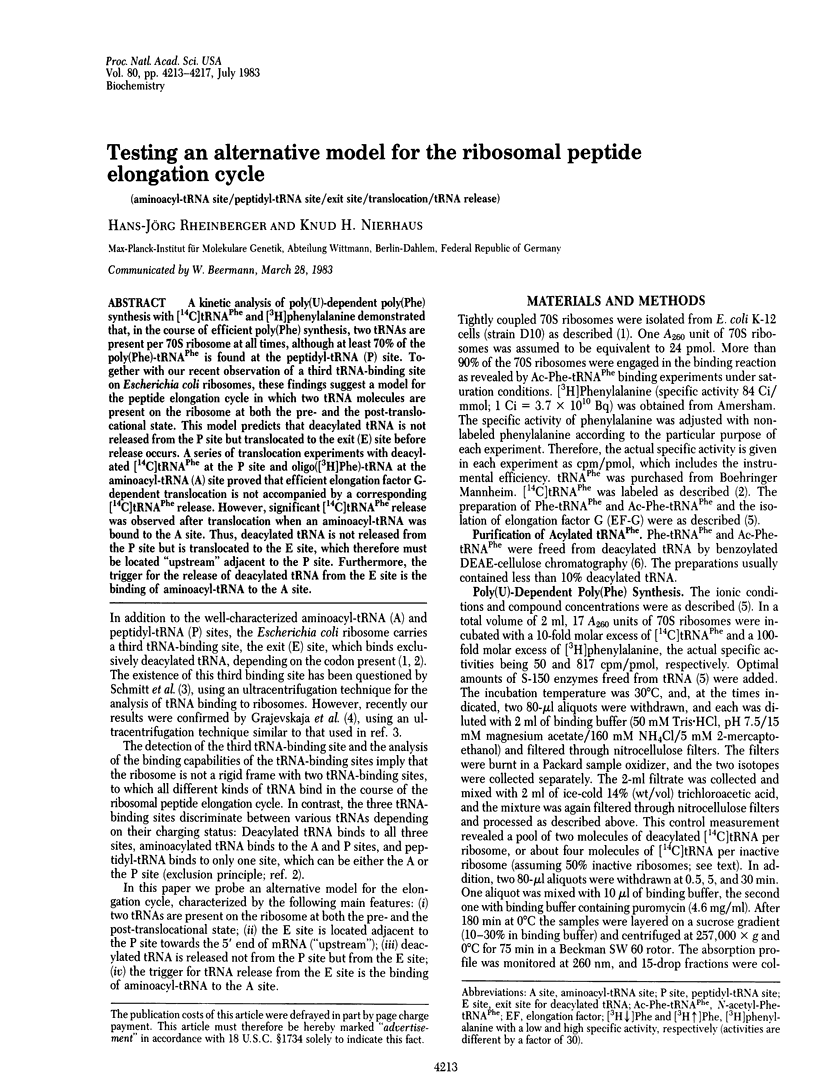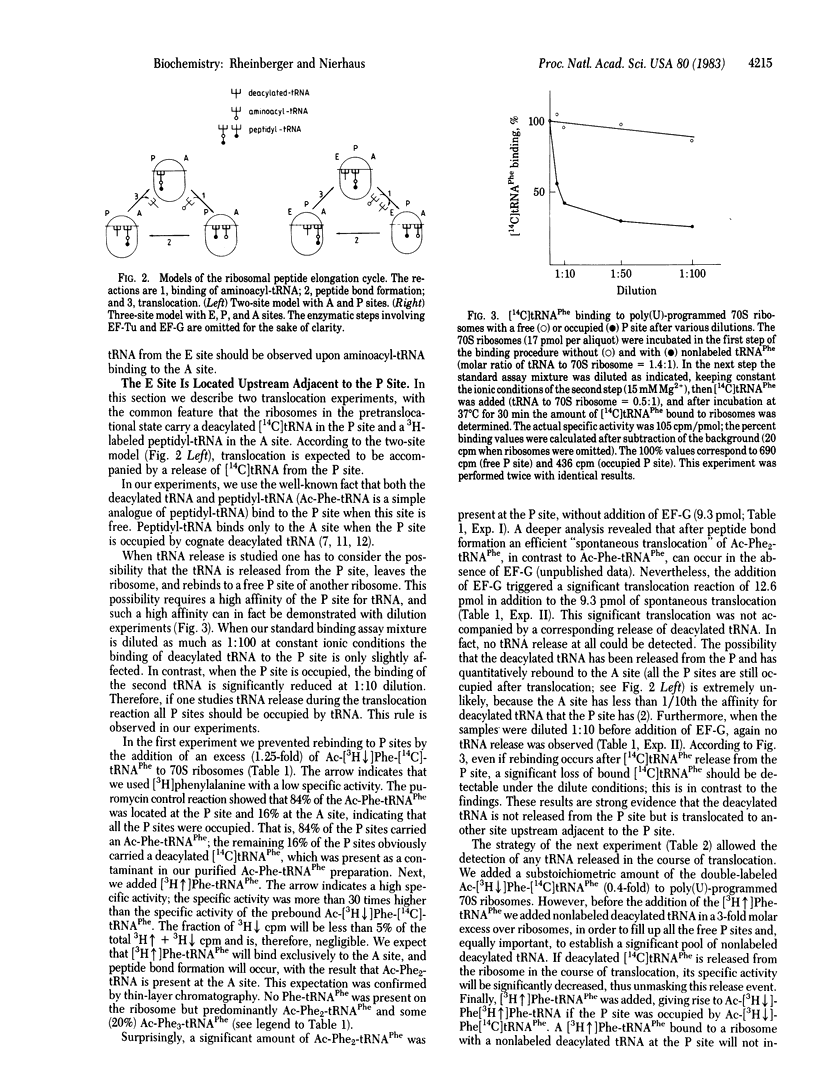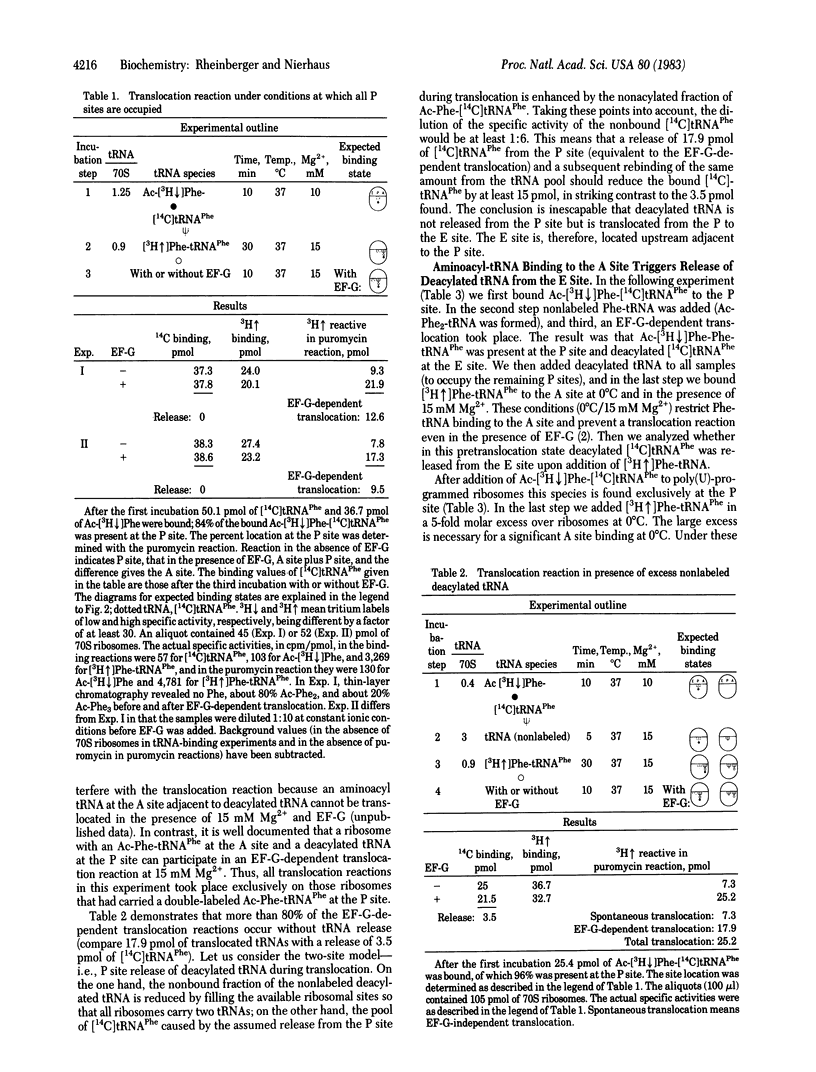Abstract
A kinetic analysis of poly(U)-dependent poly(Phe) synthesis with [14C]tRNAPhe and [3H]phenylalanine demonstrated that, in the course of efficient poly(Phe) synthesis, two tRNAs are present per 70S ribosome at all times, although at least 70% of the poly(Phe)-tRNAPhe is found at the peptidyl-tRNA (P) site. Together with our recent observation of a third tRNA-binding site on Escherichia coli ribosomes, these findings suggest a model for the peptide elongation cycle in which two tRNA molecules are present on the ribosome at both the pre- and the post-translocational state. This model predicts that deacylated tRNA is not released from the P site but translocated to the exit (E) site before release occurs. A series of translocation experiments with deacylated [14C]tRNAPhe at the P site and oligo [( 3H]Phe)-tRNA at the aminoacyl-tRNA (A) site proved that efficient elongation factor G-dependent translocation is not accompanied by a corresponding [14C]tRNAPhe release. However, significant [14C]tRNAPhe release was observed after translocation when an aminoacyl-tRNA was bound to the A site. Thus, deacylated tRNA is not released from the P site but is translocated to the E site, which therefore must be located "upstream" adjacent to the P site. Furthermore, the trigger for the release of deacylated tRNA from the E site is the binding of aminoacyl-tRNA to the A site.
Full text
PDF




Selected References
These references are in PubMed. This may not be the complete list of references from this article.
- Belitsina N. V., Glukhova M. A., Spirin A. S. Elongation factor G-promoted translocation and polypeptide elongation in ribosomes without GTP cleavage: use of columns with matrix-bound polyuridylic acid. Methods Enzymol. 1979;60:761–779. doi: 10.1016/s0076-6879(79)60070-8. [DOI] [PubMed] [Google Scholar]
- De Groot N., Panet A., Lapidot Y. The binding of purified Phe-tRNA and peptidyl-tRNA Phe to Escherichia coli ribosomes. Eur J Biochem. 1971 Dec 10;23(3):523–527. doi: 10.1111/j.1432-1033.1971.tb01649.x. [DOI] [PubMed] [Google Scholar]
- Grajevskaja R. A., Ivanov Y. V., Saminsky E. M. 70-S ribosomes of Escherichia coli have an additional site for deacylated tRNA binding. Eur J Biochem. 1982 Nov;128(1):47–52. doi: 10.1111/j.1432-1033.1982.tb06929.x. [DOI] [PubMed] [Google Scholar]
- Holschuh K., Bonin J., Gassen H. G. Mechanism of translocation: effect of cognate transfer ribonucleic acids on the binding of AUGUn to 70S ribosomes. Biochemistry. 1980 Dec 9;19(25):5857–5864. doi: 10.1021/bi00566a030. [DOI] [PubMed] [Google Scholar]
- Holschuh K., Gassen H. G. Mechanism of translocation. Binding equilibria between the ribosome, mRNA analogues, and cognate tRNAs. J Biol Chem. 1982 Feb 25;257(4):1987–1992. [PubMed] [Google Scholar]
- Holschuh K., Riesner D., Gassen H. G. Steps of mRNA translocation in protein biosynthesis. Nature. 1981 Oct 22;293(5834):675–677. doi: 10.1038/293675a0. [DOI] [PubMed] [Google Scholar]
- Inoue-Yokosawa N., Ishikawa C., Kaziro Y. The role of guanosine triphosphate in translocation reaction catalyzed by elongation factor G. J Biol Chem. 1974 Jul 10;249(13):4321–4323. [PubMed] [Google Scholar]
- Ishitsuka H., Kuriki Y., Kaji A. Release of transfer ribonucleic acid from ribosomes. A G factor and guanosine triphosphate-dependent reaction. J Biol Chem. 1970 Jul 10;245(13):3346–3351. [PubMed] [Google Scholar]
- Lucas-Lenard J., Haenni A. L. Release of transfer RNA during peptide chain elongation. Proc Natl Acad Sci U S A. 1969 May;63(1):93–97. doi: 10.1073/pnas.63.1.93. [DOI] [PMC free article] [PubMed] [Google Scholar]
- Modolell J., Davis B. D. Rapid inhibition of polypeptide chain extension by streptomycin. Proc Natl Acad Sci U S A. 1968 Dec;61(4):1279–1286. doi: 10.1073/pnas.61.4.1279. [DOI] [PMC free article] [PubMed] [Google Scholar]
- Rheinberger H. J., Sternbach H., Nierhaus K. H. Three tRNA binding sites on Escherichia coli ribosomes. Proc Natl Acad Sci U S A. 1981 Sep;78(9):5310–5314. doi: 10.1073/pnas.78.9.5310. [DOI] [PMC free article] [PubMed] [Google Scholar]
- Richter D. Stringent factor from Escherichia coli directs ribosomal binding and release of uncharged tRNA. Proc Natl Acad Sci U S A. 1976 Mar;73(3):707–711. doi: 10.1073/pnas.73.3.707. [DOI] [PMC free article] [PubMed] [Google Scholar]
- Schmitt M., Neugebauer U., Bergmann C., Gassen H. G., Riesner D. Binding of tRNA in different functional states to Escherichia coli ribosomes as measured by velocity sedimentation. Eur J Biochem. 1982 Oct;127(3):525–529. doi: 10.1111/j.1432-1033.1982.tb06903.x. [DOI] [PubMed] [Google Scholar]
- Tanaka N., Lin Y. C., Okuyama A. Studies on translocation of F-MET-tRNA and peptidyl-tRNA with antibiotics. Biochem Biophys Res Commun. 1971 Jul 16;44(2):477–483. doi: 10.1016/0006-291x(71)90626-7. [DOI] [PubMed] [Google Scholar]
- Tanaka S., Kaji A. Does translocase (G-factor) require the presence of unesterified +RNA on the donor site for its action? - the effect of fusidic acid. Biochem Biophys Res Commun. 1972 Jan 14;46(1):136–142. doi: 10.1016/0006-291x(72)90641-9. [DOI] [PubMed] [Google Scholar]
- WARNER J. R., RICH A. THE NUMBER OF SOLUBLE RNA MOLECULES ON RETICULOCYTE POLYRIBOSOMES. Proc Natl Acad Sci U S A. 1964 Jun;51:1134–1141. doi: 10.1073/pnas.51.6.1134. [DOI] [PMC free article] [PubMed] [Google Scholar]
- Watanabe S. Interaction of siomycin with the acceptor site of Escherichia coli ribosomes. J Mol Biol. 1972 Jun 28;67(3):443–457. doi: 10.1016/0022-2836(72)90462-7. [DOI] [PubMed] [Google Scholar]
- Wurmbach P., Nierhaus K. H. Codon-anticodon interaction at the ribosomal P (peptidyl-tRNA)site. Proc Natl Acad Sci U S A. 1979 May;76(5):2143–2147. doi: 10.1073/pnas.76.5.2143. [DOI] [PMC free article] [PubMed] [Google Scholar]
- Wurmbach P., Nierhaus K. H. Isolation of the protein synthesis elongation factors EF-Tu, EF-Ts, and EF-G from Escherichia coli. Methods Enzymol. 1979;60:593–606. doi: 10.1016/s0076-6879(79)60056-3. [DOI] [PubMed] [Google Scholar]


